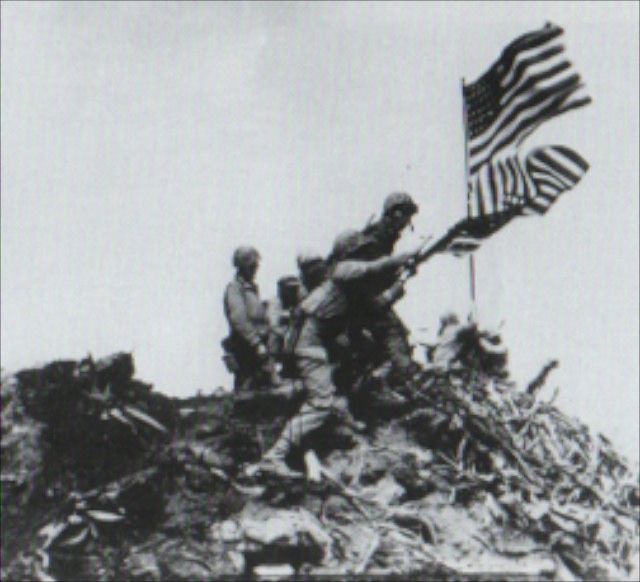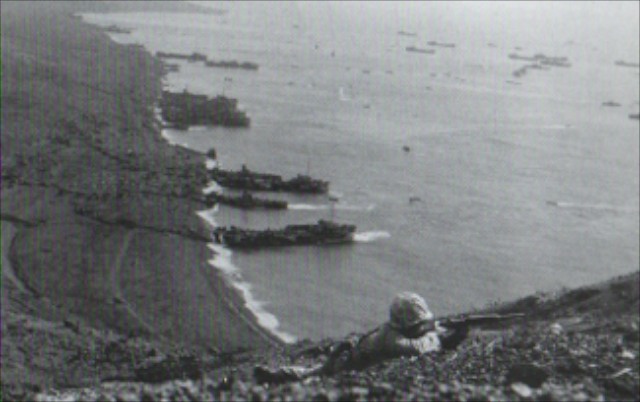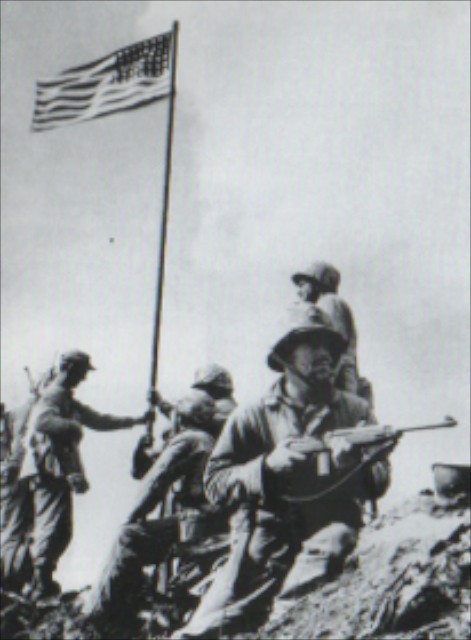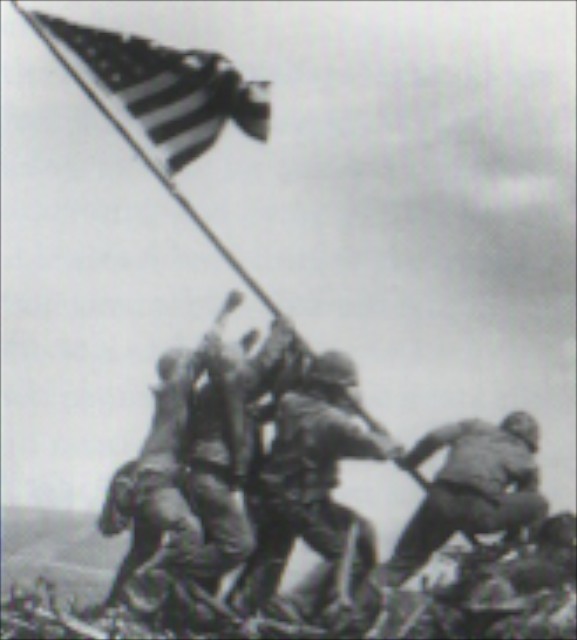Flags of Our Fathers
James Bradley and Ron Powers address and solve the controversy surrounding the famous photo of the flag raising on Iwo Jima, February 1945.
by Nancy Kerstetter
The photograph of the flag raising on Mt. Suribachi, Iwo Jima, is one of the most famous historic photographs of modern history. What people may not know now is that it was the focus of a hotly contested dispute shortly after it was published in February 1945 at the height of a ferocious, bloody, month-long World War II battle for Iwo Jima. James Bradley and Ron Powers’ book, Flags of Our Fathers, wades in the muck to make a healthy contribution toward clarifying what actually took place.
 The photograph shows six Marines raising the American flag on a makeshift flag pole atop the only high ground on the island, Mt. Suribachi. Its presence was visible for miles, including the U. S. Navy ships offshore. Posting the colors was a statement to the well entrenched Japanese army numbering 22,000 that the Marines were there to stay.
The photograph shows six Marines raising the American flag on a makeshift flag pole atop the only high ground on the island, Mt. Suribachi. Its presence was visible for miles, including the U. S. Navy ships offshore. Posting the colors was a statement to the well entrenched Japanese army numbering 22,000 that the Marines were there to stay.
The controversy centers on three points; the supposition that this was the first American flag raised on Iwo Jima, the contention that the photograph was posed not candid and finally, the mystery surrounding the identities of the six Marines hoisting the flag.
The state of communications and ability to relay frontline photographs to the U. S. in 1945 was haphazard and risky. Photographers sent their film via airplane to be developed off site, then censors and editors culled through the usable prints, sending only the best back to the States for possible publication. Fortunately, Associated Press photographer Joe Rosenthal’s famous Iwo Jima flag raising made the cut and ended up on the front pages of America’s newspapers. Meanwhile, Rosenthal was still in the Pacific war theater totally unaware of the sensation his photo was making.
 Newspaper editors presumed they correctly identified the photograph as the flag being raised on Iwo Jima, the first time an American flag flew over Japanese property. Actually it was the second time American colors were displayed in those circumstances. Bradley and Powers tell the story of the first and second flag raisings on Mt. Suribachi. They know the true account because Bradley’s father, John “Doc” Bradley, was one of the men who helped put up the second flag. It is an interesting anecdote, made more valuable by the fact that the six flag raisers did not believe they were doing anything historically significant since they were simply replacing a small flag with a larger one on a taller pole.
Newspaper editors presumed they correctly identified the photograph as the flag being raised on Iwo Jima, the first time an American flag flew over Japanese property. Actually it was the second time American colors were displayed in those circumstances. Bradley and Powers tell the story of the first and second flag raisings on Mt. Suribachi. They know the true account because Bradley’s father, John “Doc” Bradley, was one of the men who helped put up the second flag. It is an interesting anecdote, made more valuable by the fact that the six flag raisers did not believe they were doing anything historically significant since they were simply replacing a small flag with a larger one on a taller pole.
The photographer was not able to develop his film or see the prints that were passed on to the U. S. As a result, he had no idea of the patriotic commotion his photo was causing or which photo it was. After he took the famous photo, he had a group of Marines pose by the posted flag. A few weeks later, when a fellow photojournalist asked if the incredibly popular photo was posed. Rosenthal assented thinking the photo in question was the one he set up. So rumors began to fly that the flag raising photo was a posed picture.
 The third bone of contention was the identity of the flag raisers. In the heat of battle, they were anonymous Marines. Rene Gagnon, one of the six, attempted to identify the others, but made some mistakes. He had not been part of the platoon on the mountain, but had come up as a courier at the last moment and lent a hand to the heavy pole the men were raising. For several months, one of the Marines was misidentified. Not all the flag raisers survived Iwo Jima, so even they could not correct the misidentification had they known it existed.
The third bone of contention was the identity of the flag raisers. In the heat of battle, they were anonymous Marines. Rene Gagnon, one of the six, attempted to identify the others, but made some mistakes. He had not been part of the platoon on the mountain, but had come up as a courier at the last moment and lent a hand to the heavy pole the men were raising. For several months, one of the Marines was misidentified. Not all the flag raisers survived Iwo Jima, so even they could not correct the misidentification had they known it existed.
For the record, the flag raisers were: Mike Strank, Harlon Block, John Bradley, Ira Hayes, Rene Gagnon and Franklin Sousley.
One more factor, though minor, bears acknowledgement. Editors originally identified the flag as being hoisted by valiant men in complete disregard of the bullets flying by as they risked their lives to raise the flag. In truth, the mountaintop was identified as secured. No bullets were in their vicinity except those already expended or undischarged in weapon magazines.
Bradley and Powers make a careful and critical examination of the swirling controversy and come up with the right answers.
Unfortunately, the authors do a clumsy job explaining the convoluted series of battles raging on the island. Granted, it was a tangled orchestration of numerous clashes taking place simultaneously on the rugged terrain of Iwo. The Marines lost hundreds of men attempting to land on the beaches. Communications were spotty between the leaders offshore and the platoons on land, but the authors have the advantage of writing 55 years later. It seems they should have been able to tell the story more clearly unless they were trying to put themselves in the place of those fighting on Iwo. If that is the case, they were unsuccessful in their attempt.
 The best part of this book lies in the last 100 pages where author Bradley begins to tell the after story, what happened to the three flag-raising survivors after the war was over. He interviewed numerous friends and relatives of Gagnon and Hayes to piece together their stories, but he searched his own heart and memory to tell his father’s post war life.
The best part of this book lies in the last 100 pages where author Bradley begins to tell the after story, what happened to the three flag-raising survivors after the war was over. He interviewed numerous friends and relatives of Gagnon and Hayes to piece together their stories, but he searched his own heart and memory to tell his father’s post war life.
His father returned to his home state, finished his mortuary training, married and began work in his hometown. It is really an uncomplicated tale of a man who, like thousands of World War II veterans, simply wanted to go home, get married, have children, work at useful employment and get on with their lives. After all, the baby boom from the late 1940s to the early 1960s was a direct result of veterans seeking normalcy after surviving a hellacious war experience far from their home shores.
You can obtain this book from your local library, inter-library loan or Amazon.